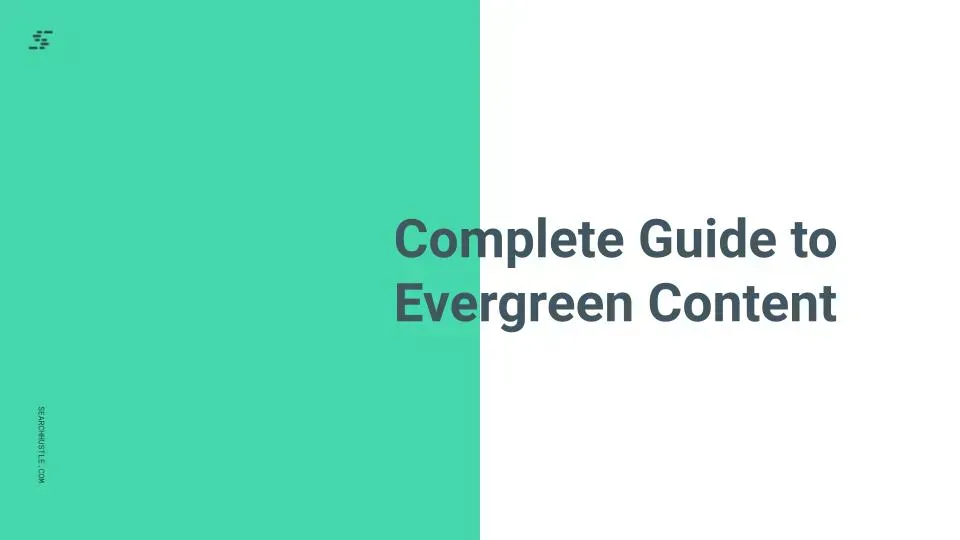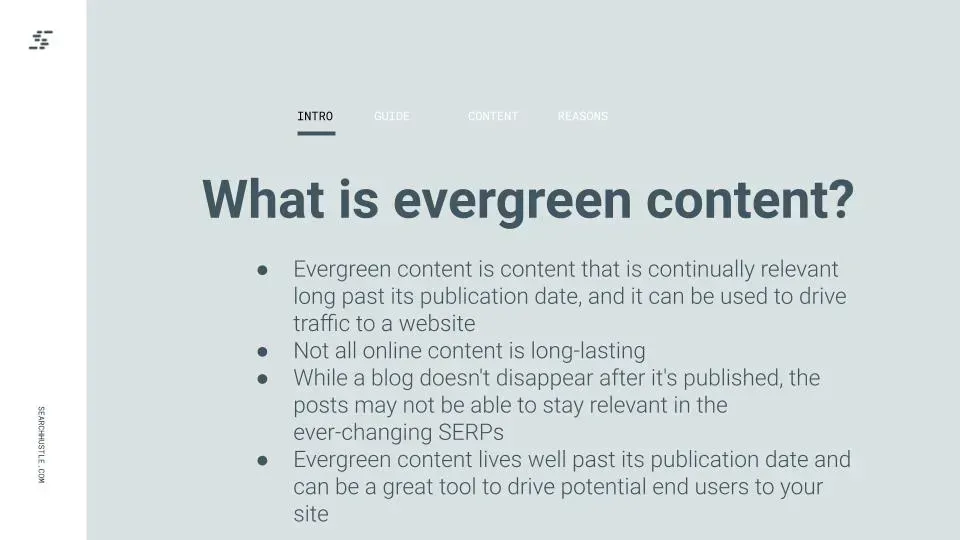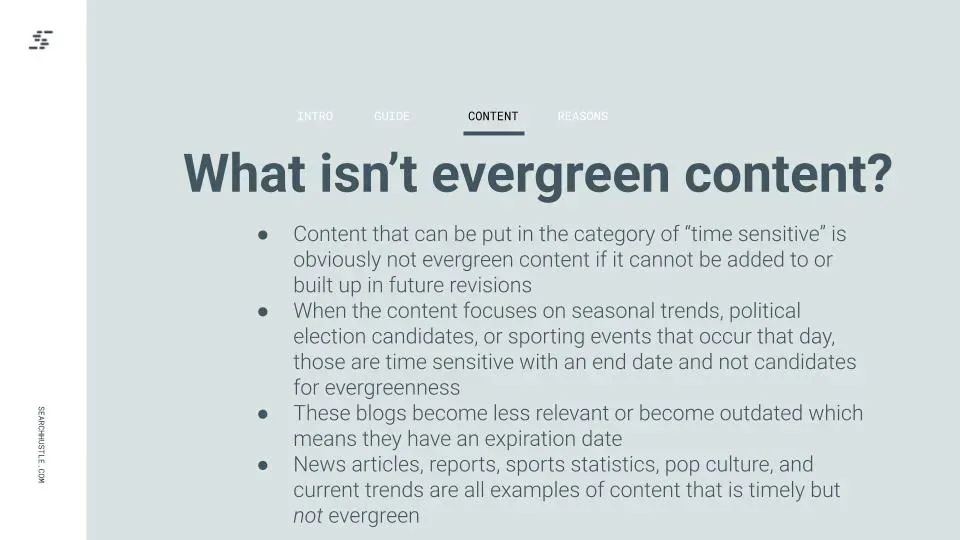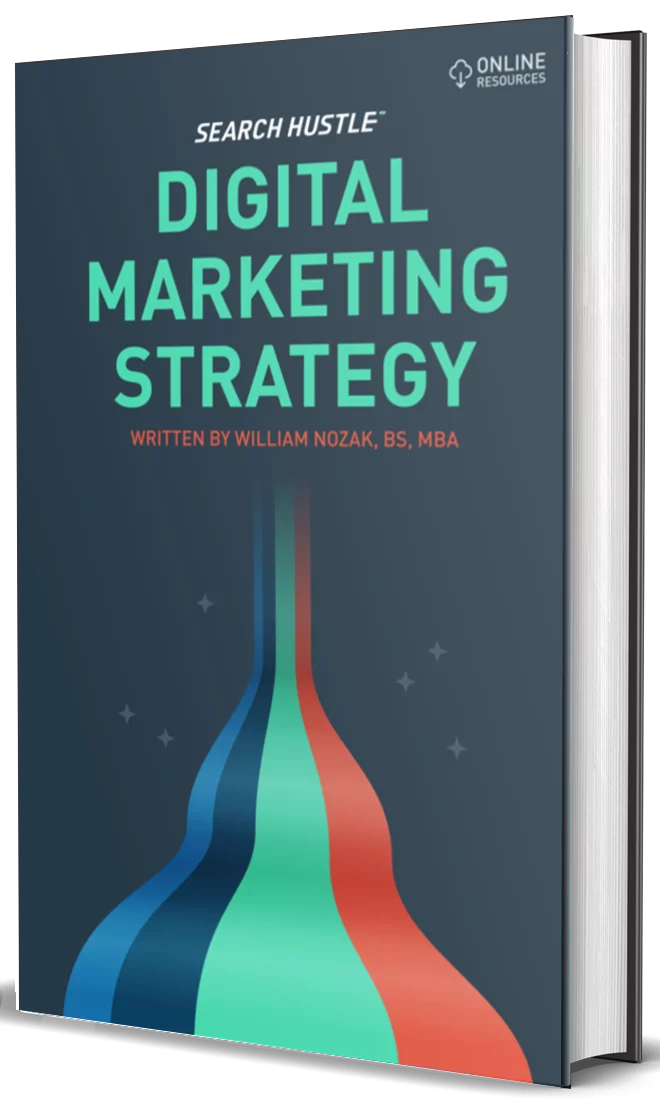Complete Guide to Evergreen Content
Assess how the business can improve by using competitor research to uncover the strengths and weaknesses of businesses in the same market as you.

Evergreen content are pages that are always relevant and fresh for readers. Whether annually, quarterly, or even monthly, update this content to ensure they are still on top of the ever-changing industry trends and relevant to the current market and consumer needs.
Evergreen pages are a great way to attract passive web traffic and generate leads that never dry up. In contrast, non-evergreen blogs tend to have a shorter life expectancy which will stop bringing SERP visitors when they stop ranking in the search Engines.
Think evergreen blogs. Because while blog content speaks to additional topics, an evergreen blog can capitalize on trend and informational changes, which helps to keep a page/post relevant and up to date.

What is Evergreen Content?
It’s been a long running joke that Hostess Twinkies have a shelf life that could withstand the ravages of time, but that just isn’t true. Twinkies only have a shelf life of about a month, but evergreen content never spoils or rots because it can stay fresh forever. Evergreen content is content that is continually relevant long past its publication date, and it can be used to drive traffic to a website.
Some businesses believe that all online content is long-lasting, but that couldn’t be further from the truth. However, it is true that a blog doesn’t disappear after it’s published, but it might not stay relevant in the ever-changing SERPs. Evergreen content lives well past its publication date and can be a great tool to drive potential end users to your site.

What Isn’t Evergreen Content?
Now that we’ve discussed what evergreen content is, let’s talk about what it isn’t. Content that can be put in the category of “time sensitive” is obviously not evergreen content if it cannot be added to or built up in future revisions. When the content focuses on seasonal trends, political election candidates, or sporting events that occur that day, those are time sensitive with an end date and not candidates for evergreenness. These blogs become less relevant or become outdated which means they have an expiration date.
News articles, reports, sports statistics, pop culture, and current trends are all examples of content that is timely and not evergreen.
5 Reasons Evergreen Content is Important
- Drives potential end users to your sales funnel
- Continually drives traffic to your site
- Brand your company as an industry leader
- Connect with your audience on social media
- Rank higher on search engines
Tips For Writing Evergreen Content
Now that we’ve lightly covered what is and what isn’t evergreen content, how should you write it? Here are some specific tips for writing evergreen content:
Choose the right keywords. Long-tail keywords might work best, and if people aren’t searching for that particular topic, the content may or may not win in the SERPs. Do the keyword research to find the words and phrases that people are searching for.
Optimize for SEO. Search engine optimization is one of the best methods for on-page optimization, and adding images, images with text, and using keywords in the structure of the content adds so much to your site. However, you should never practice “keyword stuffing” where you try to use the keywords as much as possible in the content. Google started to notice this practice years ago and they have started penalizing abuses.
Write for Beginners: Writing copy that your readers understand is vital in customer engagement. Most bloggers write at around an 8th grade level, using words and phrases that everyone can understand – which also matches the bell-shaped curve on reader level, shockingly.
Avoid Overly Technical Language: Using technical language to prove you’re an industry leader can actually turn off the reader. There’s no doubt that you are the expert, but write in a way that caters to beginners, intermediates, and professionals. Writing over heads can cause a severe disconnect, forcing readers to click off of the content.
Repurpose Your Content: When you finally write a blog that speaks to everyone, you can also spin the content into other stories, re-using the research and information you already have.
Try to Update Evergreen Content Regularly
Keep your evergreen content up to date. When you post an evergreen story, it can be tweaked and adjusted in the future. There might be new facts or findings that come to light, and since you want to be seen as the industry leader, make those changes and keep the content fresh. Also, updating content can help with SEO rankings, and once you’ve updated your story, promote it as if it’s new content.
Easy Evergreen Content Ideas
Creating evergreen content should be a continuous goal for your business, and it can help with your digital marketing campaigns. If you need some ideas for more evergreen content, here is a list of subjects that can get you started:
A Complete Guide to____.
The post you are reading is a “Complete Guide to Evergreen Content” and this particular guide is considered evergreen content. Complete guides are often popular with searchers because the research is all in one place.
Everything You Need to Know About ____.
These are generally exhaustive pieces about a particular subject or topic. With these posts, make sure to leave no stone unturned in your research in order to make it “everything you need to know…”
“What Went Wrong” Story
Stories that break down what went wrong with a subject or product are great evergreen stories because it focuses on the past. These posts are obviously about what went wrong, but they also give you a chance to determine how to fix those problems.
How-to for Beginners
When a novice or beginner is searching for an article that can help them get started with a project, how-to articles will catch their eye nearly every single time. These step-by-step guides are informative and have value.
How-to for Advanced Users
By definition, how-to for advanced readers are way more technical than how-to blogs for beginners, using technical and industry-type language that some novice readers might not understand. These are written expressly for advanced users and not beginners.
History of a Product or Service
Again, writing a blog about a product or service in the past is great for evergreen content because the history of the subject won’t change. However, if the product or service has changed or been optimized, you want to update the blog and make it current.
Resources List
This type of blog provides a resource list for the reader, and these lists can be invaluable. Be sure to keep the list at a reasonable length. Don’t make the list so long that it’s impossible to get through it. A resource list of 100 is probably too much.
Best Free and Paid Tools List
You can find tons of tools online that can help you with just about anything. In digital marketing, there are free and paid research tools, but knowing which ones to choose can be difficult. That’s why a detailed list of free and paid tools could be invaluable to a reader.
How-to Checklist
How-to checklist blogs are very popular because they give a step-by-step roadmap to complete a certain task or project.
How to Choose the Best Product
This is pretty self-explanatory. Everyone wants to purchase the best product, but they might not have the time to research which product is best for them. These blogs do the research for the reader.
Don’t Bury Evergreen Content On Your Site
Don’t just set it and forget it. Evergreen content shouldn’t be buried on your website, and it should be highlighted to show the value of your content. It needs to be accessible to your site’s visitors. Here are some ways to keep your evergreen content evergreen.
- Create training guides or “how to” articles for beginners so you can ease them into what you do or sell. These can also be an introduction to your company, and it makes you an authority on the subject, as far as they know. These posts are an asset to your readers, and they can start to learn your terminology.
- Feature your evergreen blogs on your blog or “industry news” pages or even your home page. Make them easily accessible.
- Re-post your previous evergreen content periodically with updates and new features, if possible.
- Build a “start here” page on your website that walks people through your site, including your evergreen content that can answer some questions for the searcher.
- Create a social media campaign on all of your platforms that highlights your content. Build a social media campaign around your content, across all of your networks.

Ready to Take Your Search Hustle Further?



